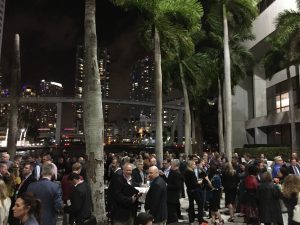
Welcome reception on the patio, just one of many networking opportunities
There is no denying that the joining of Phacilitate Leaders World and World Stem Cell Summit has resulted in a grand buffet of tasty treats to appeal to an assortment of consumers. For the second year, the two conferences have attracted academics, industry, government, bioethicists, regulators and philanthropists to Miami, Florida, for talks, partnering, networking, awards and advocacy. This year’s event was reported to have 1,600 attendees, from 40 nations, representing more than 200 organizations and 300 speakers.
With as many as seven tracks happening at one time, a new “Phacilitate: Talks” area featuring a variety of interesting speakers, workshops, and more, you need to pace yourself and prioritize if you want to sample the right content. (Here’s the agenda.)
Because the advanced therapies industry is out in force at Phacilitate, the partnering and networking opportunities are excellent, but it’s also a great meeting to hear from industry leaders and government on where the industry is heading and how are big challenges being tackled on an individual (company) or more global basis.
Last year’s conference was preoccupied with reimbursement because of the Food and Drug Administration’s (FDA) approvals of Yescarta, Kymriah and Luxturna in the final quarter of 2017 (read my post here). At the formal launch to this year’s conference, Super Plenary Chair Dr. Anthony Davies, Dark Horse Consulting, announced “The field is walking into a cost of goods (COGs) crisis.” He stated this is the next big challenge facing the industry and that we all needed to go back to work to solve this problem. (CCRM is doing what it can Anthony!)
Even so, reimbursement was still on everyone’s minds and lips. Michael Meyers, T.R. Winston & Company, discussed whether we should be paying for performance or reimbursing for value. He proposed amortizing payments for cell and gene therapies (CGTs) and creating a risk pool for stakeholders and payers to spread the risk around. You can read more about these options here.
Dave Lennon, AveXis, says the high price of CGTs is justified. He stated that the US$4-5 million price tag for a CGT that provides a cure is reasonable given how much the health-care system spends to treat patients, with chronic diseases, over their lifetimes. As the price of their gene therapy hasn’t yet been announced, I guess we can make an educated guess now.
Turning to other topics (but only briefly, as per #1 below), a popular feature of Phacilitate is an annual look back on the 10 most momentous events in our industry from the preceding year. Instead of Ed Field offering his picks, Susan Nichols, Falcon Therapeutics, was asked to step in last minute. Here’s how 2018 looked to her:
10. The end of the CRISPR patent war
9. New facilities, such as Lonza’s 300,000 sq. ft. facility in Houston, Texas (and CCRM’s slightly smaller 20,000 sq. ft. Centre for Cell and Vector Production. She didn’t really say that.)
8. Carl June named to Time Magazine’s Top 100 most influential people list
7. The FDA promises new oversight of cell-based regenerative medicine products to prevent major negative outcomes and advance innovations
6. Rise of deals in China: Kite/Gilead and Fosun Pharma establish joint venture (Yescarta); Novartis and CBMG license Kymriah; Athersys and Healios expand their collaboration. And Canada’s RepliCel gets a mention (that really happened)
5. CRISPR babies!
4. Takeda acquires Shire for US$62B
3. Moderna IPO sets record at US$604M
2. Takeda and TiGenix get first allogeneic approval for Alofisel in Europe
1. Reimbursement conversations take centre stage (a change in the treatment paradigm creates the need for alternative payment options. With 800+ active investigational new drug (IND) applications in CGT and >200/year expected by 2020.)
Janet Lynch Lambert, Alliance for Regenerative Medicine (ARM), gave the state of the industry address (see all the slides here), and she summed it up as follows:
- 2018 was a year of significant growth in the regenerative medicine sector with a rich and diverse pipeline producing positive data.
- The impact of early products for patients and families is dramatic.
- 2018 saw pronounced investor interest in the sector.
- The policy environment for CGTs is extremely positive.
- 2019 will see the sector address commercialization challenges, particularly focused on new payment models and chemistry, manufacturing and control (CMC) considerations.
If you have room for more and are still keen to read what you missed, there wasn’t a lot of Twitter activity so skimming through the week’s tweets at #PLW2019 and #WSCS2019 won’t be that onerous. If you’d prefer to watch the highlights, RegMedNet’s Freya Leask posted daily.
Stacey Johnson
Latest posts by Stacey Johnson (see all)
- Right Turn: Stem cell supplements: A growing market with growing risks - December 19, 2025
- Right Turn: Beyond the ’stache: The science, the progress, the promise - November 26, 2025
- Right Turn: Can Bryan Johnson live forever? Will regenerative medicine help him do so? - October 10, 2025







Comments